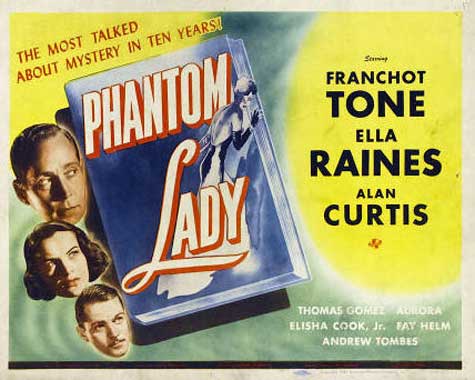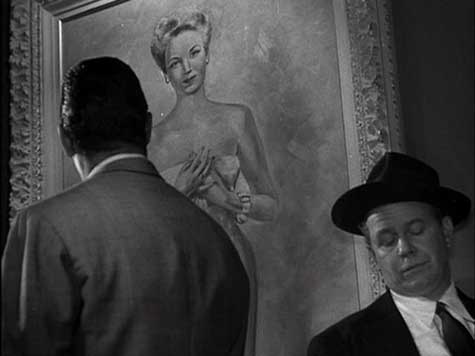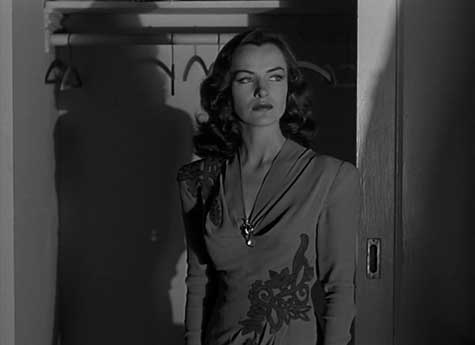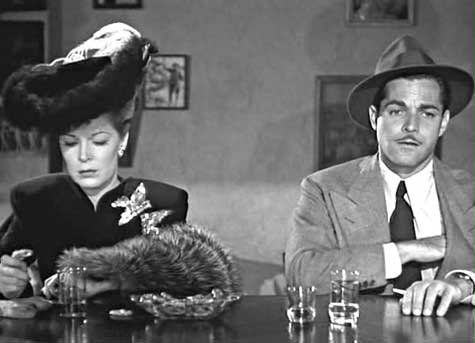
To celebrate the 70th anniversary of film noir’s landmark year, we’re looking at the six key noirs of 1944: Double Indemnity, Laura, Murder My Sweet, Phantom Lady, When Strangers Marry, and The Woman In the Window. Last week we looked at Edward Dmytryk’s Murder, My Sweet. Today we look at Robert Siodmak’s Phantom Lady.
Sometimes when you’re watching a movie there comes a moment so wonderful that it strikes you like a revelation. You realize in an instant that you’ve lucked into something terrific. The first time I saw Phantom Lady, that moment hit me at about the ten minute mark. In the film Alan Curtis plays a civil engineer who has just had a fight with his wife. He heads to a bar for a drink, and while he’s there he meets a sad woman wearing a peculiar hat. She doesn’t seem to be in a mood to talk to anyone, but eventually Curtis convinces her to go to a show. She agrees, but on one condition: they will not exchange names. He agrees, pays for their drinks, and they take a cab to the show. Nothing much happens at the show and once it’s over, Curtis and the woman say goodnight.
Then comes The Moment. Curtis returns home to find three men waiting for him. Who are they? We don’t know at first, but slowly we get the idea they’re cops. They direct Curtis to his bedroom. His wife has been murdered.

The quiet and suspenseful way this scene unfolds is a herald of the film to come. More than anything else, Phantom Lady is a triumph of style. The first ten minutes of the film are good, but The Style really kicks in the moment Curtis walks into his apartment to find his wife murdered. The shot begins in the dark (setting up a motif of beginning scenes in the pitch black). The cops speak in clipped sentences. When Curtis goes to his room to view his wife’s strangled corpse, we begin with a strange shot of the door (setting up another motif: there’s a lot of business with doors in the course of the film), and then he enters the room. There’s no music, just the silence of the moment punctuated by dialog. As Curtis tries to explain to the cops that he had nothing to do with his wife’s murder, his alibi unfolds in a terrific shot. Curtis is on the left side of the frame, with a huge portrait of his wife over his shoulder in the middle of the frame, and an unimpressed cop smacking gum in the bottom right of the frame. The scene ends with the three cops surrounding Curtis as the camera creeps in on him. You could watch the shot with the sound off and know what’s happening.

He’s in trouble. Before he knows it, he’ll be railroaded into the clink (filmed in an inventive courtroom scene that avoids every cliché of courtroom scenes). His only friend is his secretary, Carol (played with pluck by the almost unbelievably beautiful Ella Raines). She’s able to convince the inspector on the case, Burgess (the always dependable Thomas Gomez) to reopen his investigation. If they can find the mysterious woman in the strange hat, then they can prove Curtis’s alibi. This is a great set-up, but the story (adapted from the novel by Cornell Woolrich) is really just an excuse for scenes of suspense, as Carol travels into a seedy underworld to track down the woman and, maybe, the real killer. Now here’s the funny thing: I can tell you the killer is played by Franchot Tone in a good performance as a psycho, but as many times as I’ve seen this movie I cannot remember why he killed Curtis’s wife. That goes to show that, as is often the case with a Woolrich mystery, the questions are more interesting than the answers. What matters is how it’s all handled.

Director Robert Siodmak had come up in the bustling German film industry during the twenties alongside future masters of noir like Edgar G. Ulmer, Billy Wilder, and Fred Zinnemann. There must have been something in the water over there (something called Expressionism perhaps). Like many people, Siodmak fled Germany when the Nazis came to power in 1933, and he eventually found his way to America. By 1944, he was establishing a career as a master of suspense, though of course his notoriety would pale in comparison to the Master of Suspense, Alfred Hitchcock. Siodmak’s reputation has grown over the years, and one can only hope that it continues to grow, especially now that film noir seems to be going through a resurgence in popularity. Siodmak would be on anyone’s short list of the genre’s great practitioners, and his list of impressive credits includes masterpieces like The Killers, Cry of the City, and Criss Cross.
And, of course, Phantom Lady. Working with the great cinematographer Elwood Bredell, Siodmak created the kind of film that operates as a functioning definition of the noir style, utilizing a precise application of silence and sound, slanted angles, shadows, pools of light, slicked streets—and so much more. Of the landmark noirs of 1944, this one is the probably most visually beautiful. It is not to be missed.
Jake Hinkson, The Night Editor, is the author of The Posthumous Man and Saint Homicide.
Read all posts by Jake Hinkson for Criminal Element.

Here’s one of my favorite bits of PHANTOM LADY trivia. In Belgium, the film was released in Flemish with the title DA SPOOKDAME. Someone needs to start a punk band with that name.
This film would be one of my favorites if only for the jaw-dropping Elisha Cook sexual drum scene. But as you articulate, it’s so much more. Every time I watch it, I regard it even more fondly.
That’s exactly what’s wrong with movies today, Carl. Not enough Elisha Cook sexual drum scenes.
I haven’t seen the film in years but wandered over to this essay to see how Cookie’s drum scene was handled. To me, that scene IS the movie, a few moments that I turned into a rubber stamp back in the nineties. Anybody remember rubber stamps, pre email? Cookie and Peter Lorre, the masters of the cinematic flip out, and my buddy Harvey Parry doubled both of them.
Something odd in the courtroom scene makes me believe Siodmak must have been playing a game with the audience. As the camera pans left among the people in the courtroom we see a man (white hair, mustache) who’s wearing some flouncy white neckwear, like a makeup bib. It pans to Raines, cuts, then pans back from the same side of the courtroom, only this time it’s a dark haired woman in the flouncy neckwear. Is this meant to tease us over the fallibility of human perception?